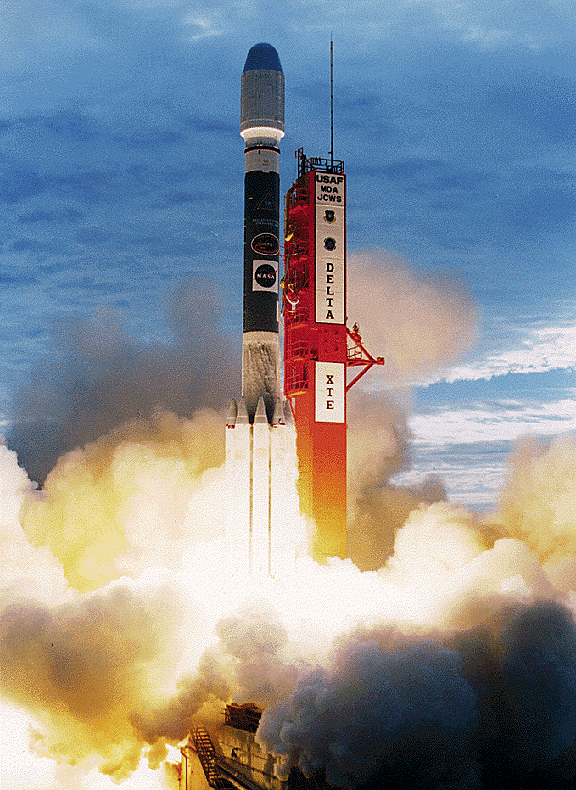About RXTE
Introduction
Although it would seem that the human eye gives us a pretty accurate view of the world, we are literally blind to much of what surrounds us. A whole Universe of color exists, only a thin band of which our eyes are able to detect; we know this visible range of color as the rainbow or the spectrum. The colors or energies of light that our eyes cannot see also have names that are familiar to us. We listen to radios, we eat food heated in microwaves, we have X-rays taken of our broken bones.
The entire range of energies of light, including both light we can see and light we cannot see, is called the electromagnetic spectrum. It includes, from highest energy to lowest: gamma-rays, X-rays, ultraviolet, optical, infrared, microwaves, and radio waves. Because we can only see visible light, we are put at a disadvantage when we study the Universe because, because it is actively emitting light at all these different energies.

With the advancement of technology, we have been able to build instruments that detect many of these different energies of light, enabling us to better understand the Universe surrounding us.
Studying X-ray Emission
X-rays are the part of the electromagnetic spectrum with wavelengths on the order of 10-10 m, and corresponding energies from about 1 keV to 200 keV.
Historically the most significant factor in the observation of X-rays is the opacity of Earth's atmosphere to these high-energy particles. The ability of our atmosphere to block X-rays is, of course, important to life on earth, but it also serves to prevent our looking at the sky and seeing objects that emit these wavelengths. In the 1960s, detectors were placed in the uppermost parts of the atmosphere, and ultimately into space, mounted on satellites.
The Rossi X-ray Timing Explorer Satellite
The Rossi X-ray Timing Explorer (RXTE), named after astronomer Bruno Rossi, probes the physics of cosmic X-ray sources by making sensitive measurements of their variability over time scales ranging from milliseconds to years. How these sources behave over time is a source of important information about processes and structures in white-dwarf stars, X-ray binaries, neutron stars, pulsars, and black holes.
The RXTE is maneuverable (6 deg/minute), so that it can be made to point to a chosen source rapidly. This flexibility allows the instrument to respond to short-lived or new phenomena as they are discovered. The instrument cannot point at less than 30 deg toward the sun (due to the Sun's X-ray "brightness".)
With instruments sensitive to a wide range of X-ray energies (from 2-200 keV), RXTE is designed for studying known sources, detecting transient events, X-ray bursts, and periodic fluctuations in X-ray emissions.
The objectives of RXTE are to investigate:
- periodic, transient, and burst phenomena in the X-ray emission from a wide variety of objects,
- the characteristics of X-ray binaries, including the masses of the stars, their orbital properties, and the exchange of matter between them,
- the inner structure of neutron stars, and properties of their magnetic fields,
- the behavior of matter just before it falls into a black hole,
- effects of general relativity which can be seen only near a black hole,
- properties and effects of supermassive black holes in the centers of active galaxies,
- and the mechanisms which cause the emission of X-rays in all these objects.
 |
Make your own RXTE Satellite model. |
The Rossi X-ray Timing Explorer Satellite & Instruments
In the drawing below, you can see the three instruments that RXTE carries: the PCA, HEXTE, and the ASM.
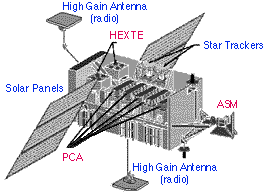
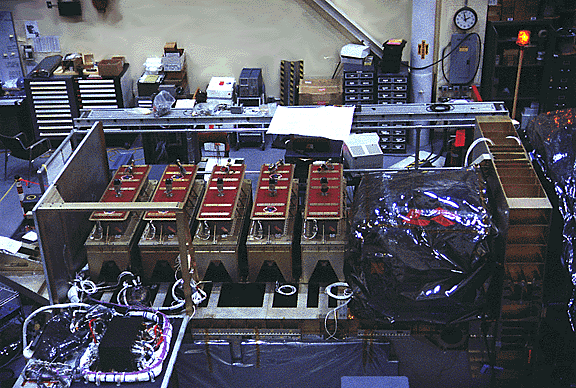 |
The Proportional Counter Array (PCA) has five xenon gas proportional counter detectors (the X-rays interact with the electrons in the xenon gas) that are sensitive to X-rays with energies from 2-60 keV. The PCA has a large collecting area (6250 cm2). The PCA's pointing area overlaps that of the HEXTE instrument, increasing the collecting area by another 1600 cm2.
|
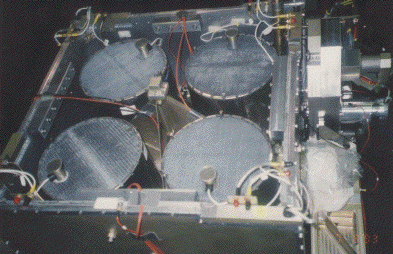 |
The High Energy X-ray Timing Experiment (HEXTE) extends the X-ray sensitivity of RXTE up to 200 keV, so that with the PCA, the two together form an excellent high resolution, sensitive X-ray detector.
|
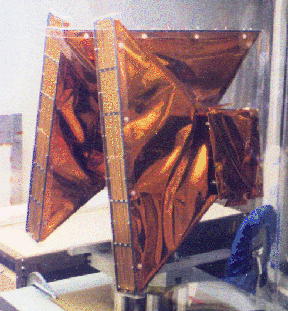 |
The All Sky Monitor (ASM) rotates in such a way as to scan most of the sky every 1.5 hours, at 2-10 keV, monitoring the long-term behavior of a number of the brightest X-ray sources, and giving observers an opportunity to spot any new phenomenon quickly.
|
Data Analysis
Information on events occurring in the PCA detectors is handled by the Experiment Data System (EDS), a microprocessor-driven on-board data system. The EDS is capable of processing up to 500,000 counts per second, and can time the arrival of individual X-rays to about 1 microsecond. The data can be collected in a number of different data modes simultaneously. This facilitates collection and analysis of the data appropriate to different sources. (Data from HEXTE is handled similarly by a separate data system.)
Data from different EDS and HEXTE data modes and are placed in separate files. From these files, an astronomer extracts light curves and energy spectra. The astronomer then applies knowledge about the RXTE instruments to convert measured quantities into physical quantities (e.g. convert channels of a pulse height spectrum into energy measured in kilo-electron Volts (keV)).
Astronomers use light curves to analyze short-term or long-term changes in intensity of a source. Further analysis of the light curves may reveal the presence of periodicities or the make-up of complex variations. Such studies may yield the size of the object or of the orbit the object may be in around another body.
The energy spectra are analyzed by fitting the data with models of possible energy sources. Statistics determine how well each model fits the data and may be used to eliminate inappropriate models. Successful analysis may determine, for example, the amount of energy emitted by the object and the source of the energy emission. Emission or absorption lines found in the spectrum further measure the composition of material in or surrounding the object.


